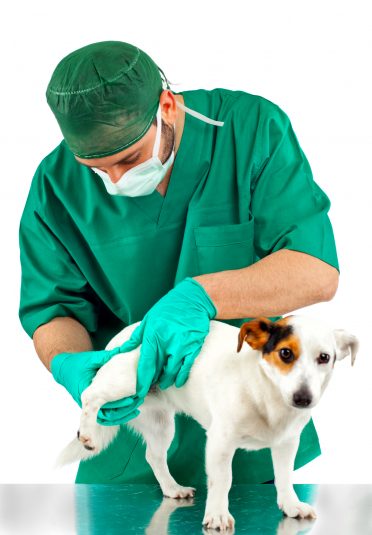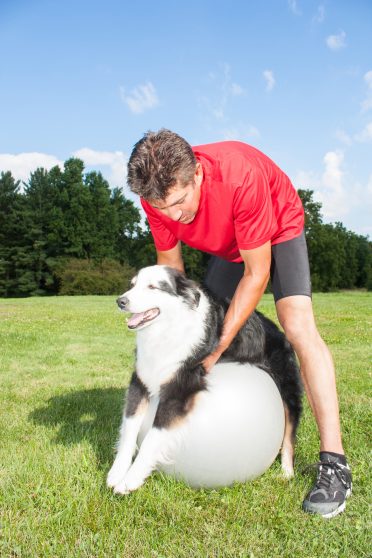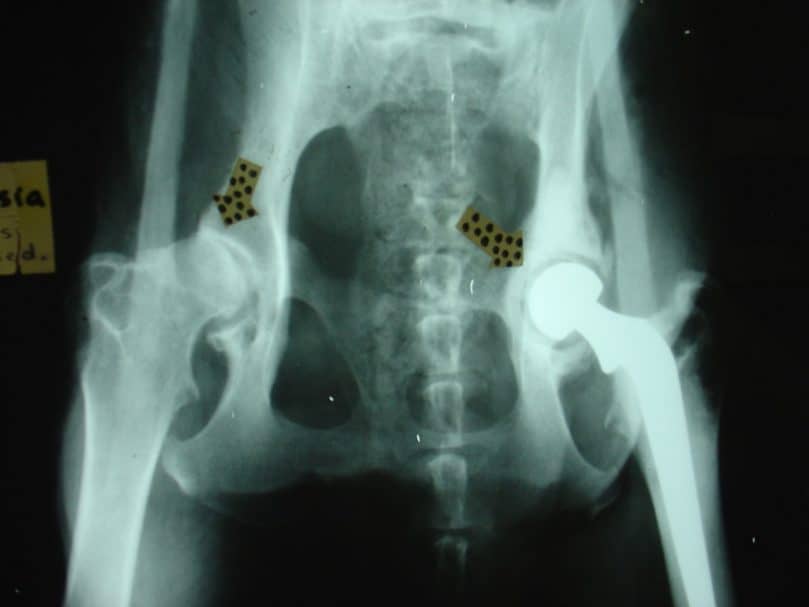This page contains affiliate links. We may earn money or products from the companies mentioned in this post through our independently chosen links, which earn us a commission. Learn More
 Unilateral hip dysplasia is a type of hip dysplasia that affects large dogs mostly, in their first year of life. It’s a condition that is caused by microfractures in the cartilaginous area. These microfractures come as a result of different factors, such as improper weight, genetic predisposition, excessive growth rate, exercise rate, etc.
Unilateral hip dysplasia is a type of hip dysplasia that affects large dogs mostly, in their first year of life. It’s a condition that is caused by microfractures in the cartilaginous area. These microfractures come as a result of different factors, such as improper weight, genetic predisposition, excessive growth rate, exercise rate, etc.
I have compiled an article about this condition, learn more below.
Contents & Quick Navigation
What is Hip Dysplasia in dogs?
It’s a common deformity or skeletal condition in canines. It causes discomfort and pain, as well as mobility problems, especially if left untreated.
To better understand how it works, all human parents must understand what a dog’s normal hip joint looks like.

The typical hip joint is a smooth ball-in-socket structure.
But with hip dysplasia, the ball doesn’t develop normally and makes the socket too shallow to be able to hold it in place. The mismatch will cause stress and damage, then will later on progress to losing its function.
No one would be able to predict when and if a dog will show clinical signs aside from the obvious pain. But the severity of this condition can be affected by different environmental factors.
Hip Dysplasia screenings are performed by vets using x-rays and will be sent to the Orthopedic Foundation for Animals (OFA) for grading.
Hip Screening for dogs: Grade Classification
The OFA classifies the hips of canines into seven categories.
| Grading | Description |
| EXCELLENT |
|
| GOOD |
|
| FAIR |
|
| BORDERLINE |
|
| MILD |
|
| MODERATE |
|
| SEVERE |
|
The grades under fair, good, and excellent are within the normal limits and will be given OFA numbers. This record will be accepted by the AKC or American Kennel Club on dogs that are in the public domain and have permanent identification.
Radiograph results of borderline, mild, moderate, and severe hip grades will be reviewed by radiologists, and the radiographic reports are generated, documenting all the findings that aren’t normal.
What can cause Canine Hip Dysplasia?

Some factors may be the cause for hip dysplasia to develop. But there are two primary causes for it – genetics and diet.
Hip Dysplasia is hereditary, and some breeds are more prone to getting this condition.
It’s common in larger breeds like Saint Bernards, German Shepherds (GSD), and Labrador Retrievers. If they go bigger than their already massive structure, it will put a lot of stress on their joints.
Other factors such as excessive growth rate, improper nutrition, and weight, as well as too little or too much exercise, can exacerbate this genetic predisposition or cause it.
Even owners of toy or miniature dogs aren’t off the hook. Smaller breeds can still inherit hip dysplasia, and can also magnify it with an unhealthy diet and obesity.
What are the signs of Hip Dysplasia in canines?
It’s different for all dogs. Others can start showing symptoms as early as 4 months old, while some may have it overlap with osteoarthritis as they grow older. It often takes years of gradual bone deterioration before a dog show clinical signs.
The effects will depend on how severe is the condition of your pet, how bad is the inflammation, how long has the dog been suffering from the disease, as well as how loose the joint is.
These are some of the visible signs that you will see or feel if your dog have joint problems:
- Stiffness
- Pain
- Decreased activity
- Having difficulty or reluctant to rise, walk, run, jump, or climb the stairs
- Loose joint
- Lameness in the rear end
- Loss of muscle mass in the thigh area
- Narrow stance
- “Bunny hop” gait
- Noticeable growth of their shoulder muscles since they have to balance the rear end
- Some would limp or appear wobbly.
When and How is Canine Hip Dysplasia diagnosed?
Diagnosing this health problem is quite simple. Your dog would have to undergo a physical exam, get some x-rays done, and to try manual tests that would involve his legs and hips.

A vet would test the hind legs of your dog to test how loose the joint is and to see if there’s any pain, grinding, or decreased range in motion.
Some blood work may also be needed since inflammation due to joint problems can be included in the results.
The veterinarian would also ask about your pet’s health background and any symptoms you noticed. Did your dog ever have any injuries or accidents that could have caused the signs you or the vet observed, as well as any information about the dog’s parents?
Definitive diagnosis for dysplasia is usually from x-rays or radiographs. It can determine how severe the issue is, and will help tell the best treatment your dog should have.
If you think that your pet may have hip dysplasia, make sure he gets radiographed as soon as possible!
Treatment Options: Can Hip Dysplasia in dogs be cured or fixed?
Ranging from modifying your dog’s lifestyle to getting surgery, there are a few ways to treat canine hip dysplasia. Again, it would always depend on the case of your dog.

If it’s not that severe, a vet may provide some nonsurgical approach such as:
- Reducing weight to take away the stress from the hips.
- Make sure your dog gets his daily exercise, but avoid high impact activities like jumping. The goal is to keep your canine friend mobile and to bring back the strength around the support structures.
- Physical therapy is very beneficial and effective at improving the quality of life of hip dysplasia victims. In fact, this should be part of any treatment regimen.
- NSAIDS or Nonsteroidal anti-inflammatory drugs such as joint fluid modifiers. A few prescription drugs may be tried first before finding the most effective for your dog.
If your furry buddy would need surgery, you can speak to your vet about a few choices and strategies available. The most commonly used by vets are:
(DPO/TPO) Double or Triple Pelvic Osteotomy
- Which is performed in younger dogs that are less than ten months of age.
- It’s where surgeons improve the function of the ball and socket joint by cutting the pelvic bone and rotating the segments carefully.
(FHO) Femoral Head Ostectomy
- Involves cutting the femoral head, the ball, or the hip joint, that would result in the body to create an “artificial” joint to reduce the discomfort due to hip dysplasia.
- FHO may not recreate the normal function of the hips, but it can be an excellent strategy for pain management. This is done on both young and mature dogs.

(THR) Total Hip Replacement
- This is the most effective treatment for this joint problem. It is where they replace the whole joint with plastic and metal implants.
- This will return the hip function to a more normal range and can eliminate a huge amount of discomfort brought on by dysplasia.
Managing Hip Dysplasia: How to help your dog feel comfortable
Aside from surgical and nonsurgical treatments, there are other ways that you can deal with hip dysplasia so your pooch can feel a little better.
Since you need to provide low impact exercises for your dog, you can take him for slow leash walks or even hydrotherapy. Do anything that will build back the muscles around the hip area. Then give him a relaxing massage to help relieve any pain from the workout he did.
You should also make the perfect home life for your four-legged friend. Provide soft sleeping areas like an orthopedic foam bed and utilize ramps to avoid the use of stairs. Prevent slips and falls by laying rugs on slippery floors.
If you live in a place where it snows or gets cold, keep your dog cozy by wrapping him in a sweater, coat, or even provide extra bedding. It will reduce arthritic pain during winter months.
There are holistic approaches, too. Acupuncture and acupressure can make mobility and pain management easier.
Find the best remedy and perfect your dog’s diet. Ask the vet for cartilage-protecting supplements like glucosamine, essential fatty acids, and antioxidants like Vitamin C and E.
How long can dogs live with Hip Dysplasia?
Canines who have joint problems can still reach old age.
Hip Dysplasia is not lethal and won’t affect the lifespan of your dog.
But as with any health issue, early diagnosis and treatment can make a huge difference. And as an owner, it’s up to you to make sure that your dog stays comfortable despite the condition.
If a dog’s case should be managed with drugs such as NSAIDs but is not monitored correctly, it may have side effects that can decrease the canine’s longevity.
Can Hip Dysplasia in dogs be prevented?
Even though we can’t prevent all cases of hip dysplasia, there steps that you can take as an owner to prevent the disease from developing.
From the time that you bring home your puppy, give him an appropriate diet that will give him a head start on healthy skeletal and development of the joint. It will also avoid excessive growth that commonly leads to hip dysplasia.
Here’s a video of Beckham with unilateral (right) hip dysplasia, doing different exercises for the hips or joints.
Then mix it in with appropriate levels of exercise to battle obesity and other health issues such as diabetes. So don’t be tempted to give table scraps and fatty food.
Aside from dog foods that are specifically suited for a breed’s size, there are those who also contain joint supplements. They will help canines who are prone to developing dysplasia and arthritis from puppyhood to old age.
Planning to get a new puppy or dog? Learn about the breed’s history and get it from responsible breeders, such as those registered with the AKC.
They do health screenings to make sure they only breed dogs who have hip joints with standard grade rate or higher.
Hip Dysplasia VS Arthritis in dogs
Arthritis is an ongoing or stable inflammation of one or more joints in response to stress and trauma.
It’s simply a general term to any abnormal changes in joints, and it has different types.
Degenerative Joint Disease (DJD) or Osteoarthritis
This is where the cartilage surrounding the joints has been deteriorating for a long time. Once the cartilage becomes wears down or becomes inflamed, it’s very likely to cause pain for your pet.
Elbow Dysplasia
Just like Hip Dysplasia, this is also a hereditary disease where the bones don’t develop naturally. Elbow Dysplasia causes damage to the cartilage, misalignment of the joint, chipping of the bones, often leading to chronic inflammation.
It’s also most common to large and giant dogs, and surgery is often needed to fix the problem.
Knee Dysplasia
Some dogs will have malformed knee joints, or have knee caps that pop in and out of position (luxating patella).
Dogs who experience this will be limping not unless the knee cap returns to the right place, which is most often via surgery.
Do you have any experience or stories to share about hip dysplasia in dogs? Tell us all about it in the comment box below!

Leave a Reply